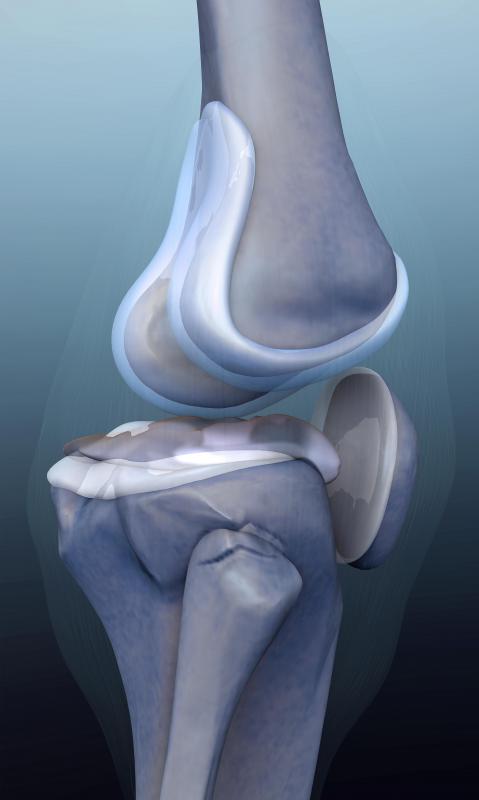At TheHealthBoard, we're committed to delivering accurate, trustworthy information. Our expert-authored content is rigorously fact-checked and sourced from credible authorities. Discover how we uphold the highest standards in providing you with reliable knowledge.
What is Connective Tissue?
Connective tissue is one of the four traditionally classified types of biological tissue. There are many different kinds, and they mainly serve as structure and support, often connecting two other types of tissue to each other. This tissue usually derives from the mesoderm, the middle of three layers in an animal embryo. Its characteristics are largely derived from the extracellular matrix, non-living material that surrounds and supports the living cells.
The older classification of this tissue had two subtypes: proper, which covered areolar and fibrous tissue, and specialized, which included bone, blood, cartilage, adipose (fat) tissue, and reticular tissue. The newer classification has four categories: loose connective tissue, dense connective tissue, cartilage, and other.

Loose connective tissue includes areolar, adipose, and reticular tissue. Areolar tissue is a mesh-like tissue with a fluid matrix that supports the epithelium, tissue that makes up the skin and other membranes. Adipose tissue is fat, which provides cushioning and insulation, lubrication in some areas, and energy storage. Reticular tissue is similar to areolar tissue, but contains only reticular fibers made of type-III collagen in its matrix. Reticular tissue supports a number of bodily structures, notably the organs of the lymphatic system.

Dense connective tissue is divided into regular and irregular types. Both have a matrix composed mainly of collagen fibers, although dense regular tissue has a matrix of parallel collagen fibers. It is very strong and connects other tissue types to each other; tendons connect muscle to bone and ligaments connect bone to bone. Dense irregular tissue has irregularly arranged collagen fibers and comprises the lower layers of the dermis, or skin.

Cartilage makes up nearly the entire skeleton of some animals, while in others, including humans, it serves mainly to cushion the joints. There are three types of cartilage: elastic, hyaline, and fibrocartilage. Elastic cartilage in rich in elastin and is found in the outer ear, the Eustachian tubes, and the epiglottis. Hyaline cartilage is characterized by a large amount of collagen and is the hardest type of cartilage. It is found on the ends on bones, in the nose and larynx, and between the ribs and sternum. Fibrocartilage contains even more collagen than hyaline cartilage, particularly type-I collagen. It is tough, heavy, white, and found in areas of high stress, such as the intervertebral discs.

The "other" category includes bone, which makes up the majority of the skeleton in adult vertebrates; blood, which transports nutrients and hormones throughout the body; and lymphatic tissues, which help transport nutrients between the blood and other cells and produce immune cells.
AS FEATURED ON:
AS FEATURED ON:















Discussion Comments
In a simplified scheme, connective tissue includes integument (skin), muscles, bones, tendons, ligaments, fascia, and various types of "filler material." It surprises me that some authorities omit muscles entirely. What were they thinking? Thomas H., D.C., Los Angeles
@Bop66: A torn ligament takes a very long time to heal. If he had torn his ulnar ligament, it would take him at least 6 months to a year to heal. I suggest him not to play football because a torn ligament has to go through a processes of healing and regenerating. No, he should not play. If he keeps playing with a torn ligament, that ligament will take much longer to heal and it could cause a permanent damage to his axillary in the future.
it was good but i want the definition of connective tissue, its classification groups then verification of its various groups. in short i want a full encyclopedia or total verification of connective tissue.
Anon50566, there are several ways to deal with scar tissue. As mentioned in one of the above posts, the healing process should not be disturbed and best to talk with your doctor before proceeding to your next level of healing.
However, most doctors have no idea how to deal with the affects of scar tissue. Eliminating scar tissue completely would mean it would have to get reabsorbed back into the body and eliminated. By taking systemic enzymes that are high in serapeptase, protease, amylase and lipase, usually taken on an empty stomach can help with the break down and reabsorption of scar tissue. You can look up Arthur Andrew Medical Inc. Medical Enzyme Development. They have some incredible formulas and I am sure you will be able to consult with someone there.
Also, be aware if you have ulcers or have a weak stomach you should consult your doctor first before taking systemic enzymes.
Yes, massage is great, but if you combine massage, or, myofascial release together with therapeutic dosages of systemic enzymes you will get superior results. Another option for you to look at - and again, be sure to get a "green light" from your doctor, is a machine called "Endermologie". It is a form of "skin rolling". Many high end spas offer that treatment.
Make sure you go to someone who is highly skilled. You can also find someone who does "Lypossage" or "Rolfing", since both of these modalities involve myofascial release. I would say Rolfing would be the better choice in your case. These are highly skilled practitioners. Find someone who has been around for a while.
One more thing, there is a machine called "Ondamed". This is an electromagnetic device that can energetically help to release the "blockages" or "lack of energy flow" in areas that have scar tissue. It is non invasive and does not involve hands on. Look it up and you will find a practitioner in your area. Hope this helps!
To answer your question anon50566, there is a way to help eliminate the scar tissue from your back surgery, but it cannot be removed. I am studying to be a massage therapist, and one of the key benefits of massage is to reduce the formation of scar tissue. It is a natural way of spreading the tissues around and eliminating the buildup of unnecessary tissue. I would wait until you are cleared by your doctor because sometimes this method can interrupt the healing process, so it is better to clear it first. The good news is that it will go away, but it will take time and effort from both your therapist and yourself. Good luck!
I just had back surgery and want to know how can the scar tissue be removed?
Hi, My son is 17 and has torn his Ulnar ligament in elbow. I am wondering if anyone knows how long this takes to heal or if with a good hinged brace it offers enough protection that he can play football? Should he not play until completely healed. Thank you, Worried Mom
Post your comments